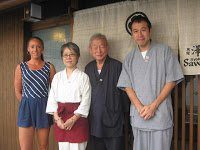 Some countries just seem so far away from the average American or British open water swimmer.
Some countries just seem so far away from the average American or British open water swimmer.
These far-flung nations are geographically distant, culturally separate and linguistically different. The food is nothing like home and the expectations of society are world’s apart.
Summer is winter and winter is summer. Left is right and right can be wrong. Travel to a foreign country and things can seem topsy-turvy, upside down, and all mixed up.
But once you meet other open water swimmers, even if you communicate via body language, and enter the water together, all differences and barriers seem to melt away.
Quicker than liquor, the bonds created by swimming together helps bring barriers down.
This year, Stephen Redmond of Ireland, Anna-Carin Nordin of Sweden, Darren Miller, Craig Lenning, Michelle Macy, Forrest Nelson and Pat Gallant-Charette of the USA traveled to Japan to cross the Tsugaru Channel.
How does an open water swimmer even begin a trip to Japan? With characters and a language as distinct from English as sushi is from steak, even knowing where to begin is a challenge.
For short swims in beautiful coastal locations, the best place to start is the Japanese International Open Water Swimming Association that organizes 14 races throughout Japan. For channel swims and swimming expeditions, the best place to start is Ocean Navi. Ocean Navi takes foreign swimmers across two of the most challenging swims in Japan – across the Sado Channel and the Tsugaru Channel.
After swims are decided, the next step is to determine the travel logistics. What airport? How to get around, from the airport to the hotel and from the hotel to the actual swim? What to eat in Japan – and where? How much do you tip? How to communicate via Internet or mobile phones?
For specific questions, ask here.
Copyright © 2012 by Open Water Source